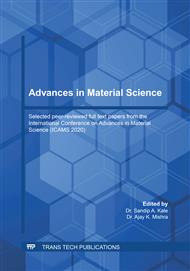[1]
Istrate, R. and Calimente, A., Slag–Utilisation in Road Construction–Experience and Solutions,, Journal of Engineering Annals of Faculty of Engineering Hunedoara, vol. 7, (2009).
Google Scholar
[2]
Qasrawi, H., Hardened Properties of Green Self-Consolidating Concrete Made with Steel Slag Coarse Aggregates under Hot Conditions,, ACI Materials Journal, vol. 117, pp.107-118, (2020).
DOI: 10.14359/51719072
Google Scholar
[3]
Aziz, M. M. A., Hainin, M. R., Yaacob, H., Ali, Z., Chang, F. L., and Adnan, A. M., Characterisation and utilisation of steel slag for the construction of roads and highways,, Materials Research Innovations, vol. 18, pp. S6-255-S256-259, (2014).
DOI: 10.1179/1432891714z.000000000967
Google Scholar
[4]
Zalnezhad, M. and Hesami, E., Effect of steel slag aggregate and bitumen emulsion types on the performance of microsurfacing mixture,, Journal of Traffic and Transportation Engineering (English Edition), vol. 7, pp.215-226, (2020).
DOI: 10.1016/j.jtte.2018.12.005
Google Scholar
[5]
Asi, I. M., Qasrawi, H. Y., and Shalabi, F. I., Use of steel slag aggregate in asphalt concrete mixes,, Canadian Journal of Civil Engineering, vol. 34, pp.902-911, (2007).
DOI: 10.1139/l07-025
Google Scholar
[6]
Hainin, M. R., Yusoff, N. I. M., Mohammad Sabri, M. F., Abdul Aziz, M. A., Sahul Hameed, M. A., and Farooq Reshi, W., Steel Slag as an Aggregate Replacement in Malaysian Hot Mix Asphalt,, ISRN Civil Engineering, vol. 2012, p.459016, (2012).
DOI: 10.5402/2012/459016
Google Scholar
[7]
Kumar, P. and Kumar, A., Steel industry waste utilisation in road sector of India,, Journal of the Institution of Engineers. India. Civil Engineering Division, vol. 80, pp.182-185, (2000).
Google Scholar
[8]
Sumi, N. and Malathy, R., Experimental investigation on effect of fly ash and steel slag in concrete pavements,, International Journal of Research in Engineering & Technology (IJRET), vol. 1, pp.117-124, (2013).
Google Scholar
[9]
Mathew, P., Stephen, L., and George, J., Steel Slag ingredient for concrete pavement,, International Journal of Innovative Research in Science, Engineering and Technology, vol. 2, pp.710-714, (2013).
Google Scholar
[10]
Aparicio, S., Hernández, M. G., and Anaya, J. J., Influence of environmental conditions on concrete manufactured with recycled and steel slag aggregates at early ages and long term,, Construction and Building Materials, vol. 249, p.118739, (2020).
DOI: 10.1016/j.conbuildmat.2020.118739
Google Scholar
[11]
Bagampadde, U., Wahhab, H. I. A.-A., and Aiban, S. A., Optimization of Steel Slag Aggregates for Bituminous Mixes in Saudi Arabia,, Journal of Materials in Civil Engineering, vol. 11, pp.30-35, (1999).
DOI: 10.1061/(asce)0899-1561(1999)11:1(30)
Google Scholar
[12]
Buddhdev, B. G. and Varia, H. R., Experimental Investigation on Utilization of Blast Furnace Slag as Fine Aggregate in Pavement Concrete,, Trends in Transport Engineering and Applications, vol. 3, pp.58-64, (2019).
Google Scholar
[13]
Chen, Z., Jiao, Y., Wu, S., and Tu, F., Moisture-induced damage resistance of asphalt mixture entirely composed of gneiss and steel slag,, Construction and Building Materials, vol. 177, pp.332-341, (2018).
DOI: 10.1016/j.conbuildmat.2018.05.097
Google Scholar
[14]
Amelian, S., Manian, M., Abtahi, S. M., and Goli, A., Moisture sensitivity and mechanical performance assessment of warm mix asphalt containing by-product steel slag,, Journal of Cleaner Production, vol. 176, pp.329-337, (2018).
DOI: 10.1016/j.jclepro.2017.12.120
Google Scholar
[15]
Goli, H., Hesami, S., and Ameri, M., Laboratory Evaluation of Damage Behavior of Warm Mix Asphalt Containing Steel Slag Aggregates,, Journal of Materials in Civil Engineering, vol. 29, p.04017009, (2017).
DOI: 10.1061/(asce)mt.1943-5533.0001832
Google Scholar
[16]
Sofilić, T., Mladenovič, A., and Sofilić, U., Defining of EAF steel slag application possibilities in asphalt mixture production,, Journal of Environmental Engineering and Landscape Management, vol. 19, pp.148-157, (2011).
DOI: 10.3846/16486897.2011.580910
Google Scholar
[17]
Wen, H., Wu, S., and Bhusal, S., Performance Evaluation of Asphalt Mixes Containing Steel Slag Aggregate as a Measure to Resist Studded Tire Wear,, Journal of Materials in Civil Engineering, vol. 28, p.04015191, (2016).
DOI: 10.1061/(asce)mt.1943-5533.0001475
Google Scholar
[18]
Jiang, L., Dong, C.-L., and Wang, S.-Y., Reducing Volume Expansion of Steel Slag by Using a Surface Hydrophobic Waterproof Structure,, Journal of Materials in Civil Engineering, vol. 32, p.04020303, (2020).
DOI: 10.1061/(asce)mt.1943-5533.0003320
Google Scholar
[19]
Hasita, S., Suddeepong, A., Horpibulsuk, S., Samingthong, W., Arulrajah, A., and Chinkulkijniwat, A., Properties of Asphalt Concrete Using Aggregates Composed of Limestone and Steel Slag Blends,, Journal of Materials in Civil Engineering, vol. 32, p.06020007, (2020).
DOI: 10.1061/(asce)mt.1943-5533.0003148
Google Scholar
[20]
Hasita, S., Rachan, R., Suddeepong, A., Horpibulsuk, S., Arulrajah, A., Mohammadinia, A., and Nazir, R., Performance Improvement of Asphalt Concretes Using Steel Slag as a Replacement Material,, Journal of Materials in Civil Engineering, vol. 32, p.04020227, (2020).
DOI: 10.1061/(asce)mt.1943-5533.0003306
Google Scholar
[21]
Liu, W., Miao, P., and Wang, S.-Y., Increasing Microwave Heating Efficiency of Asphalt-Coated Aggregates Mixed with Modified Steel Slag Particles,, Journal of Materials in Civil Engineering, vol. 29, p.04017171, 2017/10/01 (2017).
DOI: 10.1061/(asce)mt.1943-5533.0002026
Google Scholar
[22]
IS:1201-1220,(1978), (Reaffirmed 2004) Methods for testing Tar and Bituminous materials,, Bureau of Indian Standards, New Delhi, India.
Google Scholar
[23]
IS:2386,(1963), (Part I):(reaffirmed 2002):Methods of test for aggregates for concrete:Part I Particle shape and size,, Bureau of Indian Standards, New Delhi, India.
Google Scholar
[24]
IS:2386,(1963), (Part IV):Methods of test for aggregates for concrete:Part 4 Mechanical properties,, Bureau of Indian Standards, New Delhi, India.
Google Scholar
[25]
IS:2386,(1963), (Part III):Methods of Test for Aggregates for Concrete: Specific Gravity, Density, Absorption and Bulking.,, Bureau of Indian Standards, New Delhi, India.
Google Scholar


